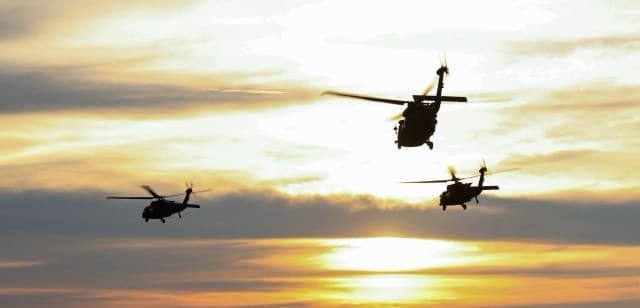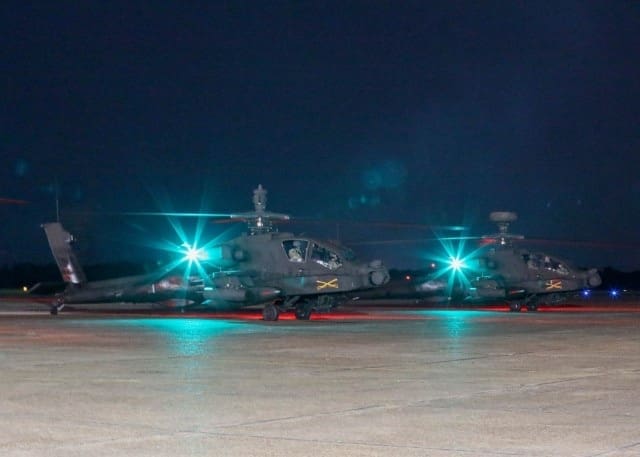
FORT CAMPBELL, Ky. –On Aug. 28, 2024, more than 3000 Soldiers assigned to the 2nd Mobile Brigade Combat Team “STRIKE”, 101st Airborne Division (Air Assault) finished their second rotation to the Joint Readiness Training Center (JRTC) in eight months. However, the beginning of the exercise was transformative and historic. The 2MBCT conducted a “large-scale, long-range” air assault (L2A2) operation consisting of 80 aircrafts, across three states, flying from Fort Campbell, Ky. to Fort Johnson, La. Aug. 13-17.
After traveling for over 500 miles, including stops at six forward arming and refueling points (FARPs), scattered over multiple southern states, the 2MBCT arrived at JRTC..
The movement method was not a typical way a brigade travels to “The Box”, but a way that was reminiscent to the founding of the 101st. Traditionally, units move by ground to Fort Johnson, spend several days preparing before entering the combat scenario. The Strike Brigade moved by air-to-ground into simulated-contested landing zones. Thus began a two-week bout with the well-known opposing forces “Geronimo,” 1st Battalion, 509th Infantry Regiment.
“The legacy that we have, dating all the way back to World War II when we were an Airborne Division fighting in Europe,” said U.S. Army Col. Travis McIntosh, the deputy commanding officer for support for the 101st Airborne Division (Air Assault) “Your 101st Airborne Division now is Air Mobile–it’s Air Assault, we have a number of helicopters. That’s how we fight in this division and we’re demonstrating that from Kentucky and Tennessee all the way down to Louisiana.”

This was much more than an aviation mission. On Aug. 13, troops and equipment from across the Division began their movement from Fort Campbell to FARP s across Mississippi and Louisiana. The sites, far from a simple pit stop along the operational path, provided vital sustainment for the troops and helicopters along the way.
“Our birds [aircraft] are able to come in get fueled, get armed and continue the fight,” said 1st Lt. James Tate, a quartermaster officer with Echo Troop, 2nd Squadron, 17th Cavalry Regiment, 101st Combat Aviation Brigade. “We can puddle hop across and get the birds further over a shorter period of time.”
The ability to send an entire brigade into an enemy area of operations further and faster is not the only aspect that allows this type of exercise to succeed – it also needs to be done at night.

“We conduct all our operations under a period of darkness,” said Tate. “We like the birds to get in, receive their fuel, get armed and off of our pads within 12 to 15 minutes.”
The quick turnaround represents a massive amount of coordination from within the division but training like this is only made possible by the support of the local communities, airports, and National Guard locations who hosted the FARPs.
“We are overwhelmed by the support from the community,” said McIntosh. “From law enforcement to the elected and appointed officials, airport management, emergency services, Louisiana National Guard, support has really poured on to the 101st Airborne Division here and we couldn’t be more grateful.”
The Soldiers of the Strike Brigade descended into JRTC for their training in an auxiliary manner as the Army continues to modernize, innovate and transform its warfighting capabilities. The L2A2 displays the combat power of today with 101st, just as airborne paratroopers did in World War II. The 101st doesn’t just keep older ways of combat entry relevant but to make those unique abilities the future of combat operations.
“We’re experimenting on some of the most modern equipment that the Army has fielded and we’re looking forward to providing that feedback to the Army,” said McIntosh. “We’re demonstrating the capability that’s only seen in the 101st Airborne Division and that’s long-range air assault.”
By SSG Kaden Pitt


As a veteran of both the 82nd and 101st, I’ve always loved the rivalry between Airborne and Air Assault. I absolutely understand the important part of rapid force projection of our Airborne units provide. In the spirit of rivalry, I’ll add that in 5 1/2 of combat, I flew into operations on helicopters more times than I can count and under canopy exactly zero times. We did submit CONOPS twice for an airborne infiltration and they were denied both times as “too risky”. Too risky?? They made us jump all the time between deployments, how was it any different really. All those Level One train-ups for nothing. On one, they cranked our jump conop and we landed MH-47s in the huge nice field we wanted to use for an MFF DZ. It was a beautiful night and would have been perfect for a jump. Oh well…Air Assault!!!!!